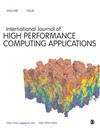人口数据驱动的COVID-19建模和学习工作流
IF 2.5
3区 计算机科学
Q2 COMPUTER SCIENCE, HARDWARE & ARCHITECTURE
International Journal of High Performance Computing Applications
Pub Date : 2021-09-01
DOI:10.1177/10943420211035164
引用次数: 25
摘要
CityCOVID是一个基于代理的详细模型,它代表了270万芝加哥居民在120万个不同的地方(包括家庭、学校、工作场所和医院)之间移动和共处时的行为和社会互动,这是由个人每小时的活动时间表和因症状发作而隔离等动态行为决定的。每个制剂中包含的疾病进展动态跟踪可能的新冠肺炎疾病状态之间的转变,基于异质制剂属性、通过共存的暴露以及个体保护行为对病毒传播性的影响。在整个新冠肺炎疫情期间,城市COVID模型输出已提供给市、县和州利益相关者,以应对不断变化的决策优先事项,同时纳入新出现的关于SARS-CoV-2流行病学的信息。在这里,我们展示了我们将高性能流行病学模拟模型与大规模机器学习相结合的努力,以开发一个可推广、灵活和高性能的分析平台,用于规划和危机应对。本文章由计算机程序翻译,如有差异,请以英文原文为准。
A population data-driven workflow for COVID-19 modeling and learning
CityCOVID is a detailed agent-based model that represents the behaviors and social interactions of 2.7 million residents of Chicago as they move between and colocate in 1.2 million distinct places, including households, schools, workplaces, and hospitals, as determined by individual hourly activity schedules and dynamic behaviors such as isolating because of symptom onset. Disease progression dynamics incorporated within each agent track transitions between possible COVID-19 disease states, based on heterogeneous agent attributes, exposure through colocation, and effects of protective behaviors of individuals on viral transmissibility. Throughout the COVID-19 epidemic, CityCOVID model outputs have been provided to city, county, and state stakeholders in response to evolving decision-making priorities, while incorporating emerging information on SARS-CoV-2 epidemiology. Here we demonstrate our efforts in integrating our high-performance epidemiological simulation model with large-scale machine learning to develop a generalizable, flexible, and performant analytical platform for planning and crisis response.
求助全文
通过发布文献求助,成功后即可免费获取论文全文。
去求助
来源期刊
CiteScore
6.10
自引率
6.50%
发文量
32
审稿时长
>12 weeks
期刊介绍:
With ever increasing pressure for health services in all countries to meet rising demands, improve their quality and efficiency, and to be more accountable; the need for rigorous research and policy analysis has never been greater. The Journal of Health Services Research & Policy presents the latest scientific research, insightful overviews and reflections on underlying issues, and innovative, thought provoking contributions from leading academics and policy-makers. It provides ideas and hope for solving dilemmas that confront all countries.

 求助内容:
求助内容: 应助结果提醒方式:
应助结果提醒方式:


